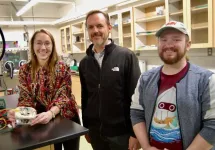(Press-News.org) You have your mother’s eyes and your father’s smile, but genetics is much more than just what’s on the surface. In a study that spans more than a decade, researchers at Baylor College of Medicine have looked at generations of families in a specific population to reveal the role newly inherited DNA variants play on recessive disease traits, and in the process, they have created a population specific database revealing unique DNA information unseen in larger cohorts.
The findings, now published in Genetics in Medicine OPEN, revealed a correlation between occurrences of complex genetic disorders in those families with increased levels of consanguinity when compared to unaffected populations. Consanguinity is when both parents contribute similar genetic markers to an offspring, such as by sharing a common ancestor, and the genetic information from both the genome inherited from the father and that from the mother are identical.
“We observed that the areas on the chromosome known as ROH, regions of homozygosity, were longer in those individuals in which there was a higher degree of parental consanguinity when compared to those with less,” said Dr. Zeynep Coban-Akdemir, postdoctoral associate in molecular and human genetics at Baylor and currently assistant professor at UTHealth School of Public Health as well as co-lead author on the study. “We can see what is happening when consanguinity is at play and also when new genetic variations are introduced into the family unit of the clan or tribe representing more distant ancestors.”
Dr. Xiaofei Song, a former Baylor graduate student now working as an assistant professor at Moffitt Cancer Center, said, “We further applied a statistical method to systematically assess the impact of these genetic variations on disease. Our results indicate that the newly introduced genetic variations can better explain the clinical features observed in our patients.” Song also is co-lead author on the study.
“The published study contributes to the field of both rare disease and population genomics. From a trainee perspective, the article provides a valuable resource for comprehending fundamental concepts of human genetics and applying diverse computational methods to elucidate these concepts,” said Ph.D candidate Tugce Bozkurt-Yozgatli, with the Acibadem University in Istanbul, Turkey.
Coban-Akdemir, who worked in the Lupski Lab at Baylor where the research was conducted, says this is an important part of the findings because it reveals how genes act within different populations and clans to contribute to different recessive genetic disorders.
The population studied was a cohort of individuals originating from Turkey that is known to have different variations in genetic markers when compared to other populations from greater Europe. Researchers created and analyzed a database of variants derived from exome sequencing, a genomics assay providing a glimpse into genetic variation genomewide, of 773 unrelated volunteers who were affected with various suspected rare Mendelian disease traits, which are diseases caused by a mutation in a single gene and clearly passed down from one generation to the next in accordance with Gregor Mendel expectations. They were compared to another database created by the same researchers of 643 unaffected relatives.
Roughly half of the genetic variants in this Turkish group are not present in greater European control populations that are found in shared databases commonly used by genetic researchers.
“This group of Turkish individuals and families gives us insight into genetics that the average population doesn’t provide. What we found in this Turkish population is very unique. Not only is this group underrepresented in larger databases, but it shows us that they have an enriched genetic variation that is only seen within this population when compared to European populations,” Coban-Akdemir said.
Dr. Davut Pehlivan, assistant professor of pediatrics – neurology at Baylor, said on a single individual there are around 40 million Watson-Crick base pair variations within our DNA.
“The Human Genome Project opened the doors for researchers to investigate entire genomic DNA complement using next-generation sequencing technology. However, more struggles appeared with these advancements. For example, it is hard to pinpoint which variant is causing disease among 40 million variations of our DNA. Studying healthy populations helps us to eliminate many of these common variations from consideration. Thus, we studied both patients and their healthy relatives in the Turkish population.” Pehlivan said. “There are a lot of changes in the genome, and we don’t fully understand the meaning of all of those details, but the data from this population study will help all investigators around the world who are trying to interpret the results of other variants in the human genome DNA.”
Pehlivan described gathering the information and families wanting to participate in genomics research beginning in 2010, traveling long distances to rural areas where the patients were mostly located, a human interest story itself, to make sure the database and clinical information would show an accurate representation for these families.
“We discovered more than 200 genes that contributed to the existing body of disease gene associations. This will help us get closer to understanding, in this population and in others, what is causing these diseases and the human biological perturbation underlying a broad scope of diseases. Our studies will open new avenues of research in human biology and genome biology and eventually help to potentially bring nucleic acid treatments, something used to develop the COVID vaccine, to the patients and families” Pehlivan said.
“This team of researchers is not just helping the population that they studied, but their findings also can be applied to many populations. We all are very different individuals on this planet, yet our genes act very similarly, and we all share a common humanity. So, understanding how genetic disorders work helps us to support affected families across the globe,” said Dr. James R. Lupski, the Cullen Foundation Endowed Chair in Genetics and Genomics at Baylor.
In the past, Coban-Akdemir and Dr. Claudia M.B Carvalho, previously with Baylor and currently in her own laboratory at the Pacific Northwest Research Institute (PNRI) in Seattle who also contributed to this study, have worked on studying variants of genes to identify causes of diseases through production of truncated or altered proteins that take on a new or different function. Their work also focused on databases of populations with and without genetic disease. Their current work reflects the importance of diversity and inclusion as work continues to reveal causes of genetic diseases.
This work was supported in part by the U.S. National Human Genome Research Institute /National Heart Lung and Blood Institute grant number UM1HG006542 to the Baylor Hopkins Center for Mendelian Genomics (BHCMG), the U.S. National Human Genome Research Institute U01HG011758 to the Baylor College of Medicine for the Genomics Research to Elucidate the Genetics of Rare Disease consortium (BCM-GREGoR), the National Institute of Neurological Disorders and Stroke Q22 (NINDS) R35NS105078, and the National Human Genome Research Institute U54-HG003273. J.E.P. was supported by NHGRI K08 HG008986.
Other authors who contributed to the study include: Francisco C. Ceballos, Ender Karaca, Yavuz Bayram, Tadahiro Mitani, Tomasz Gambin, Tugce Bozkurt-Yozgatli, Shalini N. Jhangiani, Donna M. Muzny, Richard A. Lewis, Pengfei Liu, Eric Boerwinkle, Ada Hamosh, Richard A. Gibbs, V. Reid Sutton, Nara Sobreira, Claudia M.B. Carvalho, Chad A. Shaw, Jennifer E. Posey, David Valle. They are affiliated with the Department of Molecular and Human Genetics, Baylor College of Medicine; Human Genetics Center, Department of Epidemiology, Human Genetics, and Environmental Sciences, School of Public Health, the University of Texas Health Science Center at Houston; Department of Biostatistics and Bioinformatics, H. Lee Moffitt Cancer Center & Research Institute; Instituto de Salud Carlos III, National Center of Microbiology, Madrid, Spain; Section of Neurology, Department of Pediatrics, Baylor College of Medicine; Sanford Medical Genetics Laboratory, Sanford Imagenetics; Division of Genomic Diagnostics, Department of Pathology and Laboratory Medicine, Children's Hospital of Philadelphia; Perelman School of Medicine, Un
Uiversity of Pennsylvania; Institute of Computer Science, Warsaw University of Technology; Department of Biostatistics and Bioinformatics, Institute of Health Sciences, Acibadem Mehmet Ali Aydinlar University, Istanbul, Turkey; Human Genome Sequencing Center, Baylor College of Medicine; Department of Pediatrics, Baylor College of Medicine; Department of Ophthalmology, Cullen Eye Institute, Baylor College of Medicine; McKusick-Nathans Department of Genetic Medicine, Johns Hopkins University School of Medicine; Texas Children’s Hospital; Pacific Northwest Research Institute; Baylor Genetics. To view list, along with author contributions, conflicts of interest and ethics declarations, click here.
###
END
The genomic architecture of inherited DNA variants
2024-04-10
ELSE PRESS RELEASES FROM THIS DATE:
Baylor College of Medicine wins the 2024 STAT Madness science competition
2024-04-10
Baylor College of Medicine is the champion of the 2024 STAT Madness competition!
Similar to the March Madness bracket-style basketball competition, but focused on science, this national event pits research institutions against each other for the top innovation spot in science and medicine published in the previous year.
This year, 50 institutions across the U.S. sent their candidate studies to STAT Madness, which selected 64 for the competition. The winner is elected by popular vote. After five weeks of voting that gathered nearly 270,000 votes, the Baylor team outdid the Stanford University competitor with 64.8% of the vote ...
AACR: Trio of studies highlights promising early results with new cancer therapies and targets
2024-04-10
ABSTRACTS CT037, CT038, CT042
SAN DIEGO – Three early-phase clinical studies presented by researchers from The University of Texas MD Anderson Cancer Center at the American Association for Cancer Research (AACR) Annual Meeting 2024 show promising initial data for patients with lymphoma, gastric or gastroesophageal junction cancers, and specific molecularly selected tumors. The studies were featured in a clinical trials minisymposium highlighting novel agents and emerging therapeutic strategies. Information on all MD Anderson AACR Annual Meeting content can be found at MDAnderson.org/AACR.
Novel combination with evorpacept demonstrates promising results for ...
When should a surgeon plan for a career shift? New guidelines uphold lifelong competency of surgeons
2024-04-10
As millions of Americans approach age 66, they face the inevitable question, is it time to retire? The physician population is aging alongside the general population – more than 40% of physicians in the U.S. will be 65 years or older within the next decade. In the case of surgeons, there is little guidance on how to best ensure their competency throughout their career and at the same time maintain patient safety while preserving physician dignity.
In a current study published in the Journal of the American College of Surgeons, the American College of Surgeons (ACS) ...
Survival rates after hip or spine fracture worse than for many cancers
2024-04-09
A new article in JBMR Plus, published by Oxford University Press, indicates that patient survival rates after hip or other bone fractures can be very poor. While patients and their families may dismiss a fracture as a minor injury, survival rates can be lower than those for many types of cancer.
Scientists have gathered a body of evidence about mortality outcomes in patients over 50, but survival rates following bone fractures are not often included in the statistics available to patients or caregivers. The aim of this ...
Beating back bitter taste in medicine
2024-04-09
PHILADELPHIA (April 9, 2024) – The bitter taste of certain drugs is a barrier to taking some medications as prescribed, especially for people who are particularly sensitive to bitter taste. Published in Clinical Therapeutics, a team from the Monell Chemical Senses Center found that the diabetes drug rosiglitazone could partially block the bitter taste of some especially bad-tasting medications. Rosiglitazone could be added in small doses to other medicines, to make them less bitter and taste better.
This result provided new information. “To our knowledge, there are no previous reports on the bitter-blocking effect of this diabetes drug,” ...
Heart regeneration pioneer to join UW–Madison, Morgridge Institute
2024-04-09
04/09/2024
CONTACT: Deneen Wellik, wellik@wisc.edu
Heart regeneration pioneer to join UW–Madison, Morgridge Institute
MADISON — A biologist who explores the potential life-saving mechanisms of how organisms regenerate damaged heart and spinal cord tissue will join the University of Wisconsin–Madison and the Morgridge Institute for Research this fall.
Kenneth Poss, presently the James B. Duke Professor of Regenerative Biology at Duke University, explores a research area that has grown ...
Can the bias in algorithms help us see our own?
2024-04-09
Algorithms were supposed to make our lives easier and fairer: help us find the best job applicants, help judges impartially assess the risks of bail and bond decisions, and ensure that healthcare is delivered to the patients with the greatest need. By now, though, we know that algorithms can be just as biased as the human decision-makers they inform and replace.
What if that weren’t a bad thing?
New research by Carey Morewedge, a Boston University Questrom School of Business professor of marketing and Everett W. Lord Distinguished Faculty Scholar, found that people recognize more of their biases in algorithms’ decisions ...
This device gathers, stores electricity in remote settings
2024-04-09
Today wirelessly connected devices are performing an expanding array of applications, such as monitoring the condition of engines and machinery and remote sensing in agricultural settings. Systems known as the “Internet of Things” (IoT), hold much potential for improving the efficiency and safety of the equipment.
Yet stumbling blocks remain for IoT, thwarting many potential applications. How do you power these devices in situations where and when reliable electrical sources are not practically available?
Research from the University of Utah’s College of Engineering points to a possible solution in the form of a novel type of battery called ...
AACR: Video educates and connects men to prostate cancer screening options
2024-04-09
SAN DIEGO – As part of a comprehensive effort to improve cancer screenings among diverse communities, Penn Medicine’s Abramson Cancer Center (ACC) Community Outreach and Engagement team developed a culturally sensitive educational video to address prostate cancer screening disparities. In findings shared today at the American Association for Cancer Research (AACR) Annual Meeting 2024 (Abstract LB371), the team showed that the video increased knowledge about prostate cancer and screening, and reduced uncertainty about obtaining prostate ...
Culturally sensitive video targeting Black men may help increase awareness about prostate cancer
2024-04-09
SAN DIEGO – A video designed to educate Black men about prostate cancer resulted in 97% of surveyed participants acknowledging that Black men are at a higher risk of this disease and 93% saying they would get screened, according to a study presented at the American Association for Cancer Research (AACR) Annual Meeting 2024, held April 5-10.
Black men have the highest incidence of prostate cancer in the United States with 184.2 new cases per 100,000 people compared to white men with 111.5 new cases per 100,000 people, according to the National Cancer Institute’s Surveillance, ...




